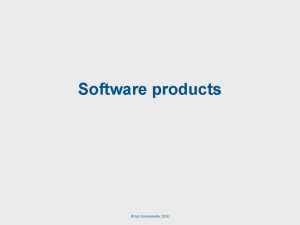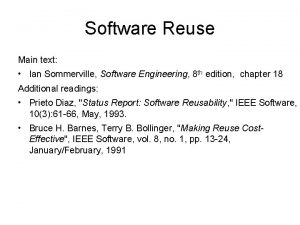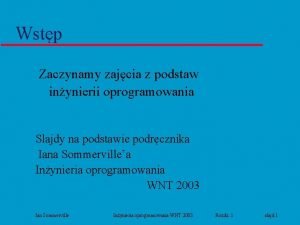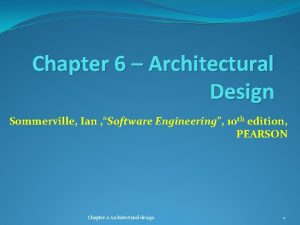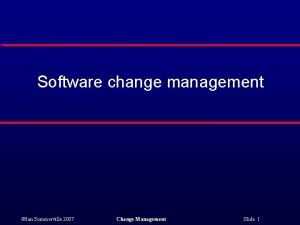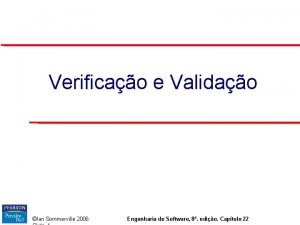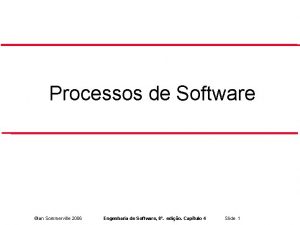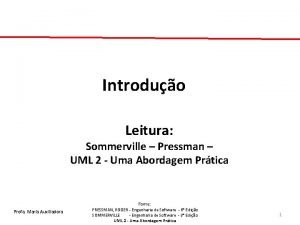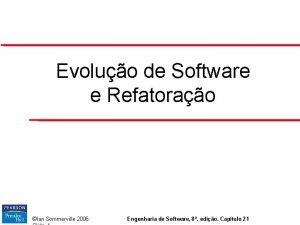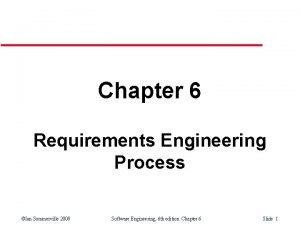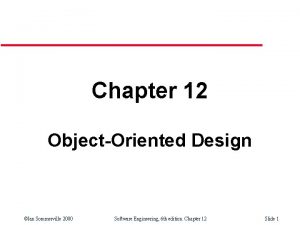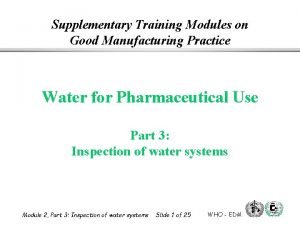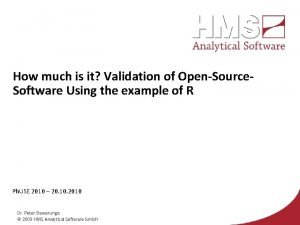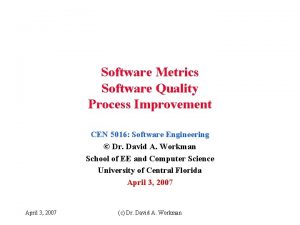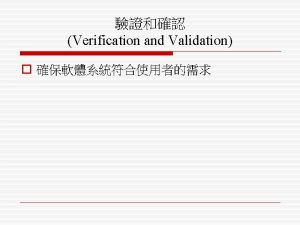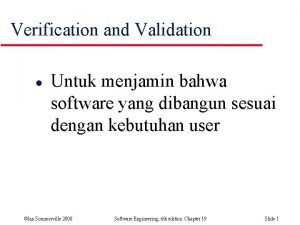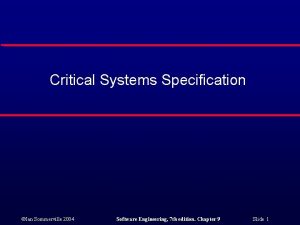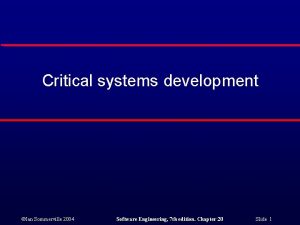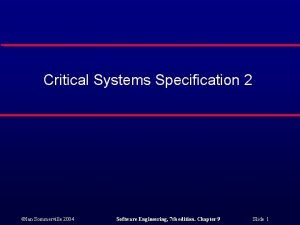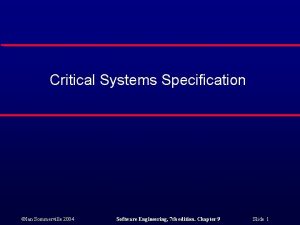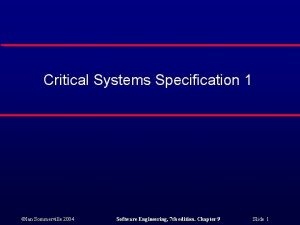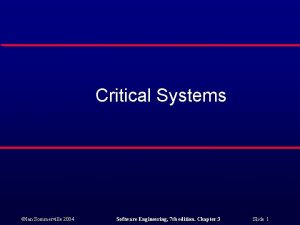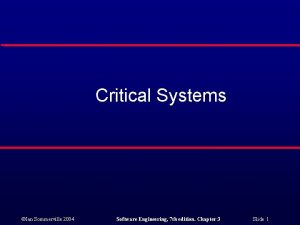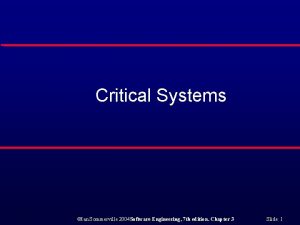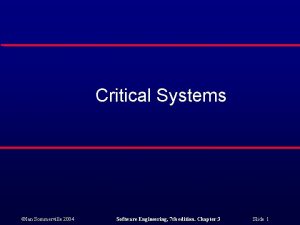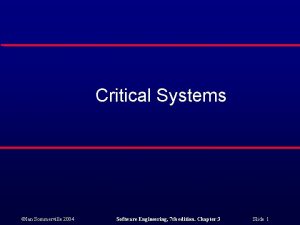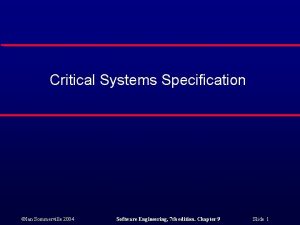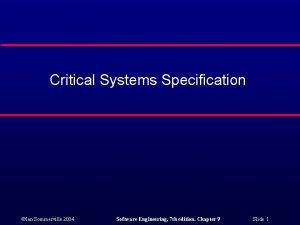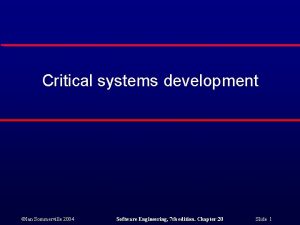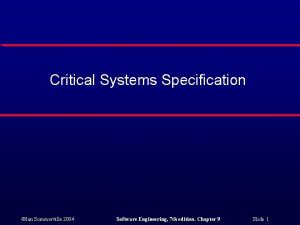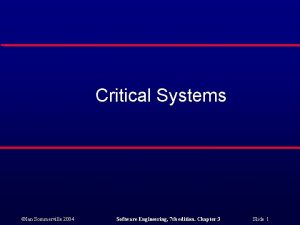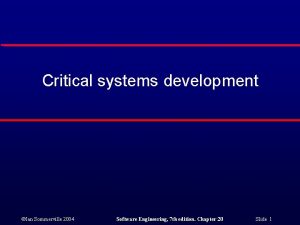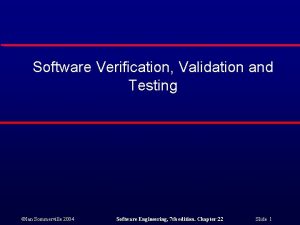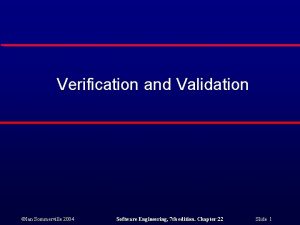Critical Systems Validation 2 Ian Sommerville 2004 Software


























- Slides: 26

Critical Systems Validation 2 ©Ian Sommerville 2004 Software Engineering, 7 th edition. Chapter 24 Slide 1

Safety assurance l Safety assurance and reliability measurement are quite different: • • Within the limits of measurement error, you know whether or not a required level of reliability has been achieved; However, quantitative measurement of safety is impossible. Safety assurance is concerned with establishing a confidence level in the system. ©Ian Sommerville 2004 Software Engineering, 7 th edition. Chapter 24 Slide 2

Safety confidence l l Confidence in the safety of a system can vary from very low to very high. Confidence is developed through: • • • Past experience with the company developing the software; The use of dependable processes and process activities geared to safety; Extensive V & V including both static and dynamic validation techniques. ©Ian Sommerville 2004 Software Engineering, 7 th edition. Chapter 24 Slide 3

Safety reviews l l l Review for correct intended function. Review for maintainable, understandable structure. Review to verify algorithm and data structure design against specification. Review to check code consistency with algorithm and data structure design. Review adequacy of system testing. ©Ian Sommerville 2004 Software Engineering, 7 th edition. Chapter 24 Slide 4

Review guidance l l Make software as simple as possible. Use simple techniques for software development avoiding error-prone constructs such as pointers and recursion. Use information hiding to localise the effect of any data corruption. Make appropriate use of fault-tolerant techniques but do not be seduced into thinking that fault-tolerant software is necessarily safe. ©Ian Sommerville 2004 Software Engineering, 7 th edition. Chapter 24 Slide 5

Safety arguments l l l Safety arguments are intended to show that the system cannot reach in unsafe state. These are weaker than correctness arguments which must show that the system code conforms to its specification. They are generally based on proof by contradiction • • l Assume that an unsafe state can be reached; Show that this is contradicted by the program code. A graphical model of the safety argument may be developed. ©Ian Sommerville 2004 Software Engineering, 7 th edition. Chapter 24 Slide 6

Construction of a safety argument l l Establish the safe exit conditions for a component or a program. Starting from the END of the code, work backwards until you have identified all paths that lead to the exit of the code. Assume that the exit condition is false. Show that, for each path leading to the exit that the assignments made in that path contradict the assumption of an unsafe exit from the component. ©Ian Sommerville 2004 Software Engineering, 7 th edition. Chapter 24 Slide 7

Insulin delivery code ©Ian Sommerville 2004 Software Engineering, 7 th edition. Chapter 24 Slide 8

Safety argument model ©Ian Sommerville 2004 Software Engineering, 7 th edition. Chapter 24 Slide 9

Program paths l Neither branch of if-statement 2 is executed • l then branch of if-statement 2 is executed • l current. Dose = 0. else branch of if-statement 2 is executed • l Can only happen if Current. Dose is >= minimum. Dose and <= max. Dose. current. Dose = max. Dose. In all cases, the post conditions contradict the unsafe condition that the dose administered is greater than max. Dose. ©Ian Sommerville 2004 Software Engineering, 7 th edition. Chapter 24 Slide 10

Process assurance l l Process assurance involves defining a dependable process and ensuring that this process is followed during the system development. As discussed in Chapter 20, the use of a safe process is a mechanism for reducing the chances that errors are introduced into a system. • • Accidents are rare events so testing may not find all problems; Safety requirements are sometimes ‘shall not’ requirements so cannot be demonstrated through testing. ©Ian Sommerville 2004 Software Engineering, 7 th edition. Chapter 24 Slide 11

Safety related process activities l l l Creation of a hazard logging and monitoring system. Appointment of project safety engineers. Extensive use of safety reviews. Creation of a safety certification system. Detailed configuration management (see Chapter 29). ©Ian Sommerville 2004 Software Engineering, 7 th edition. Chapter 24 Slide 12

Hazard analysis l l l Hazard analysis involves identifying hazards and their root causes. There should be clear traceability from identified hazards through their analysis to the actions taken during the process to ensure that these hazards have been covered. A hazard log may be used to track hazards throughout the process. ©Ian Sommerville 2004 Software Engineering, 7 th edition. Chapter 24 Slide 13

Hazard log entry ©Ian Sommerville 2004 Software Engineering, 7 th edition. Chapter 24 Slide 14

Run-time safety checking l l During program execution, safety checks can be incorporated as assertions to check that the program is executing within a safe operating ‘envelope’. Assertions can be included as comments (or using an assert statement in some languages). Code can be generated automatically to check these assertions. ©Ian Sommerville 2004 Software Engineering, 7 th edition. Chapter 24 Slide 15

Insulin administration with assertions ©Ian Sommerville 2004 Software Engineering, 7 th edition. Chapter 24 Slide 16

Security assessment l l l Security assessment has something in common with safety assessment. It is intended to demonstrate that the system cannot enter some state (an unsafe or an insecure state) rather than to demonstrate that the system can do something. However, there are differences • • Safety problems are accidental; security problems are deliberate; Security problems are more generic - many systems suffer from the same problems; Safety problems are mostly related to the application domain ©Ian Sommerville 2004 Software Engineering, 7 th edition. Chapter 24 Slide 17

Security validation l Experience-based validation • l Tool-based validation • l Various security tools such as password checkers are used to analyse the system in operation. Tiger teams • l The system is reviewed analysed against the types of attack that are known to the validation team. A team is established whose goal is to breach the security of the system by simulating attacks on the system. Formal verification • The system is verified against a formal security specification. ©Ian Sommerville 2004 Software Engineering, 7 th edition. Chapter 24 Slide 18

Security checklist ©Ian Sommerville 2004 Software Engineering, 7 th edition. Chapter 24 Slide 19

Safety and dependability cases l l Safety and dependability cases are structured documents that set out detailed arguments and evidence that a required level of safety or dependability has been achieved. They are normally required by regulators before a system can be certified for operational use. ©Ian Sommerville 2004 Software Engineering, 7 th edition. Chapter 24 Slide 20

The system safety case l l It is now normal practice for a formal safety case to be required for all safety-critical computer-based systems e. g. railway signalling, air traffic control, etc. A safety case is: • l A documented body of evidence that provides a convincing and valid argument that a system is adequately safe for a given application in a given environment. Arguments in a safety or dependability case can be based on formal proof, design rationale, safety proofs, etc. Process factors may also be included. ©Ian Sommerville 2004 Software Engineering, 7 th edition. Chapter 24 Slide 21

Components of a safety case ©Ian Sommerville 2004 Software Engineering, 7 th edition. Chapter 24 Slide 22

Argument structure ©Ian Sommerville 2004 Software Engineering, 7 th edition. Chapter 24 Slide 23

Insulin pump argument ©Ian Sommerville 2004 Software Engineering, 7 th edition. Chapter 24 Slide 24

Claim hierarchy ©Ian Sommerville 2004 Software Engineering, 7 th edition. Chapter 24 Slide 25

Key points l l Safety arguments or proofs are a way of demonstrating that a hazardous condition can never occur. It is important to have a dependable process for safety-critical systems development. The process should include hazard identification and monitoring activities. Security validation may involve experience-based analysis, tool-based analysis or the use of ‘tiger teams’ to attack the system. Safety cases collect together the evidence that a system is safe. ©Ian Sommerville 2004 Software Engineering, 7 th edition. Chapter 24 Slide 26
 Engineering software products ian sommerville
Engineering software products ian sommerville Ian sommerville software engineering
Ian sommerville software engineering Inżynieria oprogramowania ian sommerville
Inżynieria oprogramowania ian sommerville Sommerville software engineering slides
Sommerville software engineering slides Critical semi critical and non critical instruments
Critical semi critical and non critical instruments Critical semi critical and non critical instruments
Critical semi critical and non critical instruments Sommerville 2007
Sommerville 2007 Sommerville
Sommerville Sommerville
Sommerville Sommerville
Sommerville Sommerville
Sommerville Sommerville
Sommerville Sommerville
Sommerville Sommerville
Sommerville Elaine sommerville
Elaine sommerville 666 rule powerpoint
666 rule powerpoint Validation of water systems for pharmaceutical use
Validation of water systems for pharmaceutical use Software validation example
Software validation example Initiating the requirements engineering process
Initiating the requirements engineering process Software metrics validation
Software metrics validation Verification and validation plan
Verification and validation plan A software verification and validation method. section 19
A software verification and validation method. section 19 Software verification and validation plan
Software verification and validation plan Data validation software
Data validation software Compare non-critical readers with critical readers.
Compare non-critical readers with critical readers. Management spectrum includes
Management spectrum includes Asp.net request validation bypass
Asp.net request validation bypass
